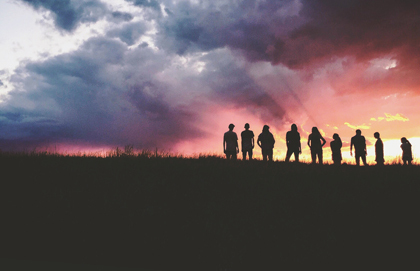In 2014, controversy broke out in Hamilton, Ont., surrounding the medical treatment of 11-year-old Makayla Sault, an Ojibwa girl from the Mississaugas. After enduring severe side effects from the chemotherapy designed to combat her acute lymphoblastic leukemia, Makayla asked her parents to remove her from the standard cancer treatment she was receiving at McMaster Children's Hospital in favour of traditional indigenous medicine.
Media opinion was passionately divided across the country, and the story brought to the surface many unresolved tensions of cultural differences, political legitimacy and indigenous sovereignty uneasily embedded within the fabric of the history of the Canadian nation-state. Some called for the Children's Aid Society to remove Makayla from her parents' care, a demand that detonated historical minefields and rekindled painful memories of forced removals of indigenous children from parents deemed unfit by the non-indigenous State. Standing in the background of this heartbreaking and politically tumultuous story, however, was a surprising character: Jesus of Nazareth.
You see, Makayla's parents are pastors at the New Credit Fellowship Centre, an evangelical congregation located on the New Credit Reserve near Hagersville, Ont. And Makayla had had a vision as she was lying in a hospital room during chemotherapy: Jesus appeared to assure her that, whether she lived or died, she would be safe in his care. After Makayla's death in January 2015, her family expressed wrenching grief tempered by the confidence that she was now at peace with Jesus.
The place of Jesus among the First Nations of North America, or Turtle Island as it is known to some indigenous nations, eschews easy categorization. The details of Makayla's story reveal the tangled complexities of competing legalities, First Nation identity and culture, the Canadian nation-state and Christianity. They also illustrate how the popular pairing of "indigenous" and "traditional" versus "foreign" and "Christian" simply will not do given the importance of Jesus in the lives of tens of thousands of First Nation members. The Christian movement should be conceived of as part of First Nation history rather than something perpetually alien and imported; and the First Nations of Turtle Island should be viewed within the global history of the Christian faith as another ongoing chapter.
The Gospel of Jesus Christ, being the fulfillment of the Creator God's redemptive plan announced to Abraham to bring about the great reversal of all that had gone awry in His creation, has a strange tendency to be cobbled together with radically different (and even opposing) metanarratives in a way that feels awkward, contradictory and sometimes baffling. Consider the Gnostic Christian disdain for the physical world, the conquering military Church- State of the high Middle Ages, or the modern prosperity gospel promising God's material blessing to those who invest the little they have in high-risk faith bonds. These narrative mixtures, so obviously out of step with the Kingdom announced by Jesus of Nazareth, continue to be reformulated into confusing hybrids that muddle the revolutionary Gospel pronouncement and subsequent law-superseding life of the Spirit. Jesus declared that a man cannot serve two masters, but it seems human nature to try and make this impossible dual loyalty a reality. One of the most powerful hybrids in recent history was the 19th and early 20th century conflation of "civilization," racial hierarchy and the good news of Jesus Christ. This cobbled bricolage of contradictory narratives produced a story that rendered non-European cultures racially primitive, culturally inferior and religiously depraved while European culture was deemed progressive, superior and Christian – destined to inherit the future. This story was particularly destructive to indigenous peoples of North America.
Foreign disease levelled Native populations, an effect enhanced by brutal warfare, forced removals and the debilitating social conditions found on shrinking reserves that lacked any kind of sustainable economic land base. Christian peoples, Christian language and Christian social programs time and again were implicated within the cultural project of conquering the Americas and remaking it into the image of civilized Europe.
Missionary work has proceeded uninterrupted in what is today known as Canada since the early 16th century, beginning with Catholic missionaries, later joined by Protestants. As the centuries passed, the settler power base continued to grow until it was potently dominant over the North American continent. The strengthening of the settler power base grew out of an explosive population increase, driven forward by the need for more land, all occurring in tandem with a sharply decreasing indigenous population and rapidly diminishing Native political power base. The encounter with foreign disease, misunderstanding-ridden treaty agreements, exponential multiplication of the settler population and the increased confinement of Native peoples onto smaller and smaller reserves absolutely overturned Native traditional life and ensured the beginning of a new era.
The residential school experiment began in earnest in the late 19th century as settler power reached its critical mass in Canada. Good or bad intentions aside, the residential school institution symbolized the project of assimilation, an educational policy that targeted the next generation of indigenous peoples, forcibly removed them from their parents and shipped them off to schools far away. All this was in the service of "killing the Indian, saving the child" and was justified on the grounds of both civilizing them and spreading the Gospel. Prior to the 19th century, missionaries had been forced to engage with local indigenous cultures and languages to present the Gospel message, mainly because there was no other way to communicate with the Native population. By the early 20th century, the Statesponsored residential schools had co-opted the support of Christian churches, employing missionaries and clergy as the first line of offence against indigenous cultures, corporally punishing Native children for speaking the very languages missionaries had once worked so hard to learn. From the perspective of the now dominant settler society, the First Nations were, above all, a problem to be solved. The goal was the elimination of the First Nations as a distinct category of humanity, the absorption of Native children into an enlightened, modern, Christian, white Anglo-American society where progress would bring about happiness and prosperity for the whole citizenry.
Residential schools embodied a story about the world: Leave primitive ways, superstitious traditions, uncouth languages and depraved customs in the past and embrace the future – progress, civilization, science, technology. The curriculum of the residential schools cobbled together this narrative of progress alongside a Gospel message encouraging students to likewise repent and be saved, learn God's word and escape the punishment of Hell. From the perspective of the federal government, the schools were dismal failures: constantly under protest by Native parents, expensive, dehumanizing and neglecting to produce assimilated Natives. It turned out residential schools could not transform a "primitive" traditional Native into a "civilized" white Christian; racial prejudice remained even after graduation, making integration into the Anglodominant society nearly impossible. The exodus to urban centres after the Second World War brought indigenous peoples of diverse backgrounds into intimate contact with one another as they congregated in friendship centres that fostered the growth of a pan-indigenous identity.
Supercharged by the Civil Rights and Red Power movements in the United States in the 1960s, coupled with a growing population for the first time since first contact, the indigenous peoples of Canada became politically active, protesting treaty violations and fighting for sovereignty within the nation-state that had been their due. The Canadian experience was part of a growing international movement of indigenous peoples – one that remains active within the halls of the United Nations, utilizing the language of human rights to fight for indigenous sovereignty across the globe.
When dealing with history spanning multiple centuries, there is no definitive way to tell the story of Christianity among the First Nations that captures the totality of the experience. As a doctoral candidate at the University of Toronto, I am hoping to bring to light one of the less prominent topics in indigenous history, that of post-war indigenous evangelicalism. The residential schools represented one particularly destructive and abusive chapter in the history of Christianity among the First Nations, but they do not denote the whole story. As the nightmarish boarding-school experiment began to wane in the 1960s and 1970s (the last school officially closed in 1996), an indigenous evangelical movement began to take shape, one that differed markedly from manifestations of indigenous Christianity in the past. This movement emerged with its own issues and prejudices as well as its own innovations and victories. With few exceptions, the post-war evangelical and Pentecostal movements among indigenous peoples have failed to capture the attention of the academy. Similarly, the individuals involved in native evangelicalism have not tended to be on the front lines of political activism, thus contributing to their invisibility. Despite the marginalization of these stories, the growth of evangelicalism is a part of the First Nations experience and history, and provides an additional layer to the story of Christianity in North America.
The decades following the Second World War witnessed a revival in missionary zeal in Canada, in "home missions" directed toward the First Nations of Canada's north, this time by conservative evangelicals. They stressed individual conversion and a personal relationship with Jesus as the solution to both the problem of a doomed afterlife and the moral issues plaguing northern communities in the here and now. The Northern Canada Evangelical Mission (NCEM), as one example, was founded in 1946 by Stan Collie, heralding a missionary movement that explicitly distinguished itself from mainline and Roman Catholic churches that had some presence among reserve communities in northern Ontario, Manitoba, Saskatchewan, Alberta and British Columbia. The NCEM considered these earlier manifestations of Christian evangelism to have been more destructive than good, bringing a base knowledge of Christian doctrine to the peoples of the North but failing to provide them with the simple Gospel of salvation by grace alone. In the mind of the new missionaries, both mainline and Catholic churches had, above all, sought to control the people of the
North, ultimately proven by their implication in the founding and running of the residential schools. Evangelicals were mainly interested in saving souls and curbing drug and alcohol abuse in the lives of converts, not in producing new citizens of the Canadian nation-state or enacting a movement of structural social reform. In the quest for converts, evangelical missionaries pragmatically reinstated the use of traditional languages to communicate the Gospel, rather than supporting an institutionalized education rooted in notions of civilization.
This revived post-war missionary movement was more careful to recognize the benefits of native leadership within the church, and the NCEM saw the emergence of several important indigenous evangelical leaders, particularly Tommy Francis, Albert Tait and Bill Jackson. Knowing the language, customs and idioms of Native people, these bicultural missionaries proved to be much more effective in their ministry across the North. Francis, in particular, was inspired by the "indigenous principle," a missiological framework that argued for a model of self-supporting, self-propagating and selfgoverning local congregations, finding its modern expression in the missiology of Henry Venn, Roland Allen and Melvin Hodges. Parallel with the rise of modern indigenous political activism and sovereignty was native Christians' embrace of the indigenous principle in the spread of the Gospel in Canada's North.
In 1957, at a gathering of native evangelical leaders at Island Lake, Man., the dream for a self-supported institutional Native Church of Canada led by First Nation believers was born – one that would be officially recognized by the Government of Canada as a denomination in 1971 – known as the Native Evangelical Fellowship of Canada (NEFC). In the 1980s, under the leadership of Joseph Jolly, the NEFC pursued the indigenous principle and training of Native leaders with vigour, fashioning a fellowship of indigenous evangelical congregations stretching from southern British Columbia to northern Quebec. While remaining heavily critical of anything that fell within the purview of Native "religion," the affirming approach taken toward Native culture and language was entirely different from the abusive assimilative practices of residential schools.
In the mid-1990s, a new missiological paradigm was embraced by a contingent of indigenous North American evangelical leaders, a theological framework that came to be known as the "contextual movement." While the postwar evangelical missionary movement sought to be culturally sensitive, to promote native leadership and to use native languages as an effective agent of preaching, those who embraced the contextual movement sought to more explicitly embrace the God-honouring aspects of indigenous worldviews, formulate innovative indigenous Christian ceremonies and engage Native religious practices with more inclusivity. Leaders like Richard Twiss, Terry LeBlanc, Randy Woodley, Cheryl Bear, Adrian Jacobs, Casey Church and Ray Aldred have inspired thousands across Canada and the United States with their embrace of Native cultures and explicit rejection of assimilationist Christian policies. At the same time, they continue to sound some alarm bells of syncretism within the white evangelical world.
However, this leadership is inspiring a new confidence and pride in Native identity among indigenous Christians as a God-given good, encouraging a holistic creational theology akin to the ancient Hebrews, eschewing western dualisms and promoting shalomic indigenous conceptions of harmony and community. Whenever Mark MacDonald, the National indigenous Anglican Bishop of Canada, gives a public lecture, he is always asked: "Why would any indigenous person choose to be a Christian today given everything that has come before?" Bishop MacDonald says the answer is simple: Jesus.
This brief overview barely begins to uncover the complexities of the story of Christianity among the First Nations of Turtle Island, but it is clear that Jesus continues to be honoured and to captivate hearts across native North America despite the extensive damage caused to indigenous minds, spirits and bodies over the past 400 years by Euro- American Christians. While being "civilized" and Christian had been awkwardly conflated throughout the 19th century and into the 20th, after the Second World War, the notion that one did not need to be white, middle-class, suburban, European, etc. to be Christian became more obvious. In fact, this had been a false correlation from the start.
I hope that my research into the history of indigenous evangelicalism in Canada widens the story of Christianity in Canada, illustrating that the residential school experiment represents a particularly abusive chapter in the history of First Nation Christianity rather than the entire story. I also hope to contribute to dismantling the notion that Christianity is somehow out of place among First Nations, particularly in the decades following the Second World War. The notion of an indigenous Christian body governed by indigenous peoples has germinated and grown into a network of institutions – one that will no doubt continue to surprise North Americans through the 21st century.






